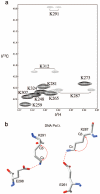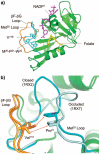Dependence of amino acid side chain 13C shifts on dihedral angle: application to conformational analysis
- PMID: 18652454
- PMCID: PMC2712834
- DOI: 10.1021/ja802729t
Dependence of amino acid side chain 13C shifts on dihedral angle: application to conformational analysis
Abstract
Chemical shift data from the BiomagResDataBank and conformational data derived from the protein data bank have been correlated in order to explore the conformational dependence of side chain (13)C resonance shifts. Consistent with predictions based on steric compression, upfield shifts for Cgamma resonances of Thr, Val, Ile, Leu, Met, Arg, Lys, Glu, and Gln residues correlate with both the number of heavy atom (nonproton) gamma-substituents and with gauche conformational orientations of gamma-substituents. The (13)C shift/conformation correlations are most apparent for Cgamma carbons but also can be observed at positions further from the backbone. Intraresidue steric conflict leads to a correlation between upfield-shifted side chain (13)C resonances and statistically lower probabilities in surveys of protein side chain conformation. Illustrative applications to the DNA pol lambda lyase domain and to dihydrofolate reductase are discussed. In the latter case, (13)C shift analysis indicates that the conformation of the remote residue V119 on the betaF-betaG loop is correlated with the redox state of the bound pyridine nucleotide cofactor, providing one basis for discrimination between substrate and product. It is anticipated that (13)C shift data for protein sidechains can provide a useful basis for the analysis of conformational changes even in large, deuterated proteins. Additionally, the large dependence of the leucine methyl shift difference, deltaCdelta1-deltaCdelta2, on both chi1 and chi2 is sufficient to allow this parameter to be used as a restraint in structure calculations if stereospecific assignment data are available.
Figures




References
-
- Wishart DS, Sykes BD. J. Biomol. NMR. 1994;4:171–80. - PubMed
-
- Wishart DS, Sykes BD, Richards FM. Biochemistry. 1992;31:1647–51. - PubMed
-
- Cornilescu G, Delaglio F, Bax A. J. Biomol. NMR. 1999;13:289–302. - PubMed
-
- Kuszewski J, Gronenborn AM, Clore GM. J. Magn. Reson., Ser. B. 1995;107:293–297. - PubMed
-
- Kuszewski J, Qin J, Gronenborn AM, Clore GM. J. Magn. Reson., Ser. B. 1995;106:92–96. - PubMed
Publication types
MeSH terms
Substances
Grants and funding
LinkOut - more resources
Full Text Sources
Miscellaneous

